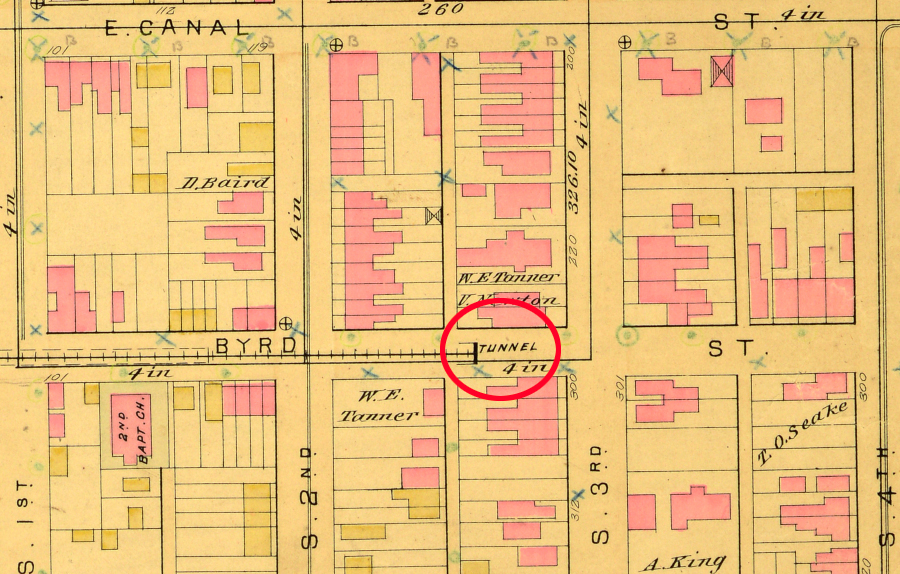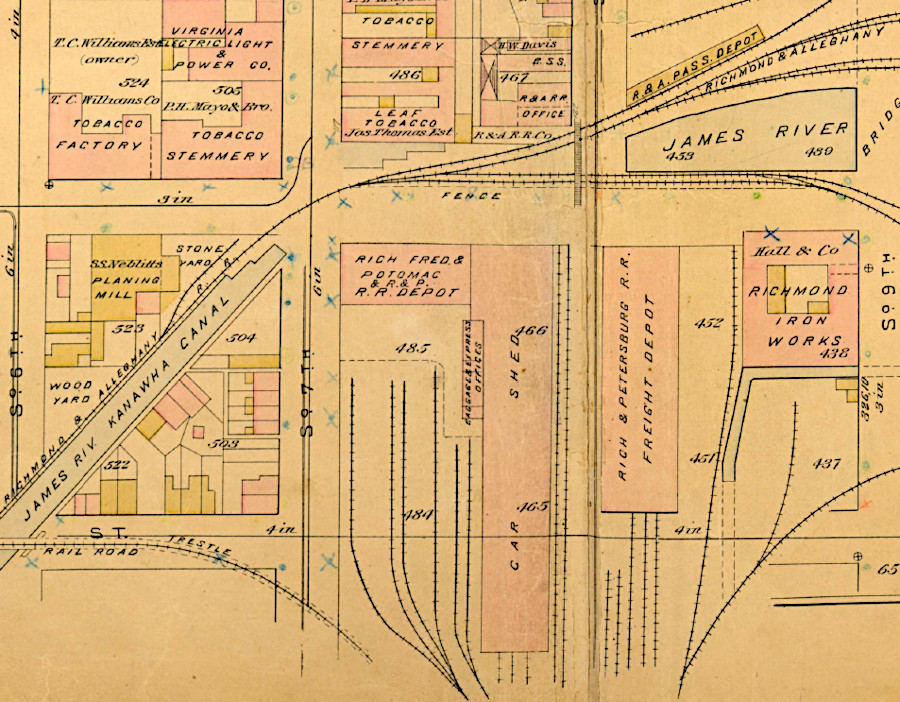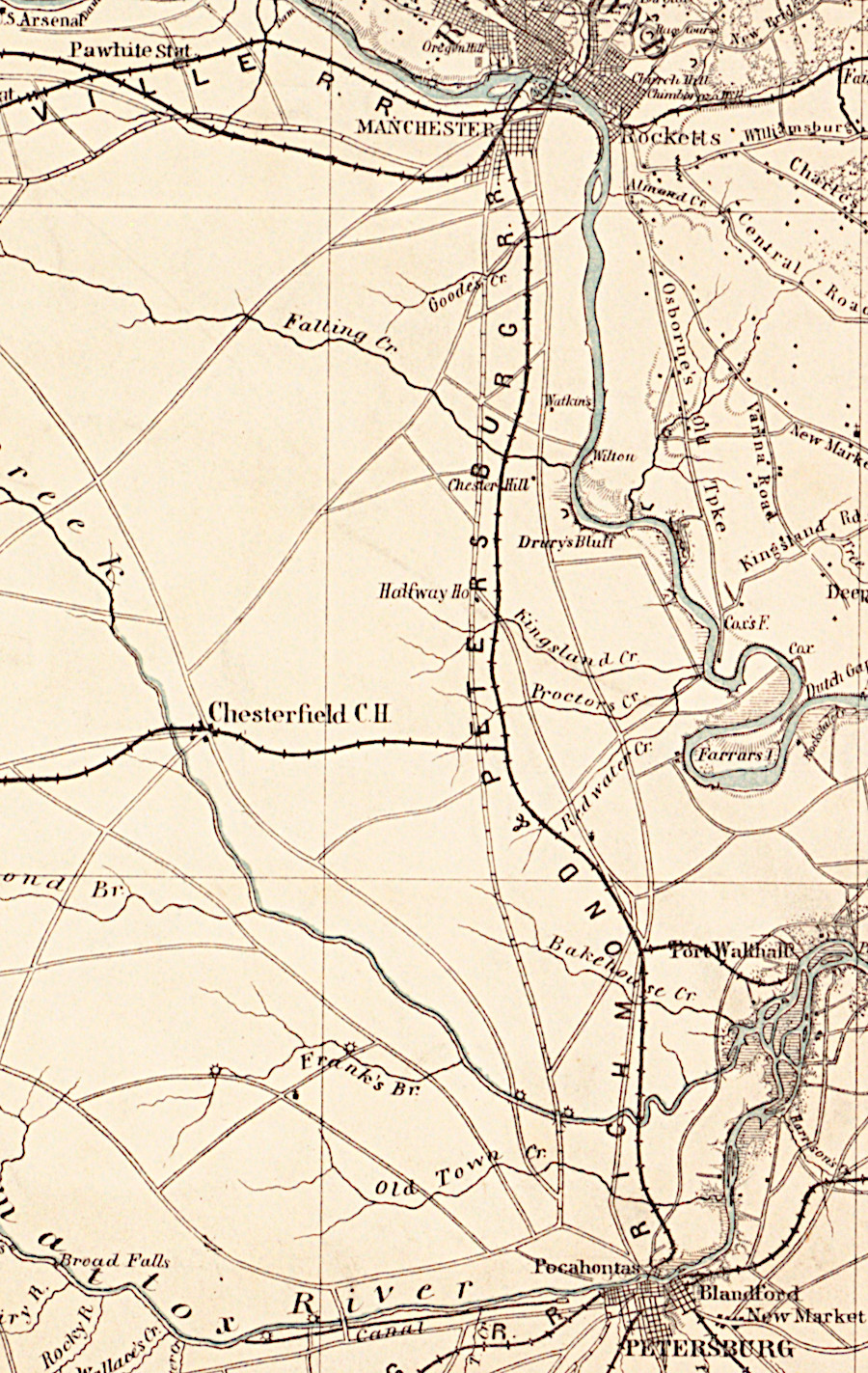Richmond and Petersburg Railroad

a spur to Port Walthall (red) gave the Richmond and Petersburg Railroad (yellow) a way to compete with the Petersburg Railroad's connection to City Point (blue)
Source: Library of Virginia, Bacon's large print war map showing 50 miles round Washington and Richmond (1864)
The Richmond and Petersburg Railroad was chartered on March 14, 1836. Its southern end was Pocahontas, the island in the Appomattox River. No bridge was constructed into Petersburg to connect track directly with the other railroads there.1
Richmond and Petersburg Railroad became embroiled in the competition for business at the ports of Richmond, Petersburg, and Norfolk/Portsmouth.
The Portsmouth and Roanoke Railroad started operating trains between Weldon, North Carolina and Portsmouth in 1837. That offered an alternative market for Roanoke River freight. Tobacco, timber products, and various agricultural products from Mecklenburg and other Southside Virginia counties had previously gone north to Petersburg via the Petersburg Railroad. Some went on to Richmond via the Richmond and Petersburg Railroad, with tobacco being processed there before shipment to final markets.
The Richmond and Petersburg Railroad initially partnered with the Petersburg Railroad to the south, and the Richmond, Fredericksburg and Potomac (RF&P) Railroad to the north, to offer a joint fare for freight/passengers going to Baltimore. The joint rail fare was lower than the Portsmouth and Roanoke Railroad fare, plus what customers had to pay a steamship company to get from Portsmouth to Baltimore.

the Richmond and Petersburg Railroad in 1856
Source: Library of Congress, Map of the Springfield & Deep Run estates on the Coal Lands of the N. York & Richmond Coal Co, in Henrico Co. Virginia (by S. Herries DeBow, 1856)
The Portsmouth and Roanoke Railroad responded by partnering with the Bay Line; their combined rail/steamship fare was low enough to divert traffic from Petersburg back to Portsmouth. Profits were sacrificed in the process. The price war ended after the Portsmouth and Roanoke Railroad went into bankruptcy in 1846.2
The Richmond and Petersburg Railroad upgraded the track to Port Walthall in 1840, where the Appomattox River channel was deeper than at Petersburg, after the City Point Railroad constructed a rail connection to City Point on the James River. The railroad also purchased a steam tug to tow ships to the dock.
Port Walthall was downstream from the wharves of Manchester and at the mouth of Gillies Creek. Ships sailing upriver could make a shorter trip to load/unload at Port Walthall, and it provided deeper water for larger ships. To prevent competitors from interrupting the steamship connection, the Richmond and Petersburg Railroad gained financial control of the Norfolk and Port Walthall Steamboat Association.3

Port Walthall was located at a deeper part of the Appomattox River than Petersburg
Source: Library of Congress, Central Virginia (1864)

the Richmond and Petersburg Railroad (red) connected with the Clover Hill Railroad (blue) at Chester, and had a branch (yellow) to Port Walthall
Source: Library of Congress, Map of the neighbourhood of Richmond and Petersburg, Virginia (by A. C. Cooke and Henry James, 1864)

the rail connection to Port Walthall helped Richmond compete with Petersburg's railroad connection to City Point
Source: Library of Congress, Hare's map of the vicinity of Richmond, and Peninsular campaign in Virginia (by J. Knowles Hare, 1862)
The Richmond and Petersburg Railroad build a bridge across the James River to access the industrial area of the city, which was located along the James River waterfront and near the turning basin of the James River and Kanawha Canal.

the Richmond and Petersburg Railroad (red line) stopped at the Byrd Street station, which was just north of the site of the Federal Reserve Bank (yellow)
Source: ESRI, ArcGIS Online

only the pilings of the Richmond and Petersburg Railroad bridge over the James River (left) still remain
Source: Virginia Commonwealth University (VCU), General View of Richmond, Va.
The track was not connected to the other railroads with terminals in Richmond. The railroads were managed as stand-alone corporations, intended to move goods from a "captive" hinterland of a particular railroad to a market city. Before the Civil War, the railroads were expected to generate their own traffic from shippers located near the track. Virginia's railroads were not planned initially to handle long-distance through-traffic, freight and passengers originating at a distant location and passing across a particular line on the way to another distant location.
There was a brief alliance between the Petersburg Railroad and the Richmond and Petersburg Railroad in the 1840's to offer streamlined ticketing and transfers, in the effort to drive the Portsmouth and Roanoke Railroad out of business. After that was accomplished, the railroads went back to business-as-usual and did not integrate their operations. In Richmond, everything was unloaded from the Richmond and Petersburg trains at the station on Canal and Eight Street. Any people or goods traveling beyond Richmond had to take a stagecoach or wagon to another railroad's terminal and get onto a separate train there.
The Civil War created a need for greater efficiency in moving supplies through Richmond to the Confederate armies in Northern Virginia and the Shenandoah Valley. The national government of the Confederate States of America directed that the railroads in Richmond be connected. City officials acquiesced, provided the connecting tracks would be removed after the military necessity was ended. Tearing up the tracks would restore jobs for teamsters and companies who made a living based on the inefficient transfers between separated railroad terminals.
During the war, the Richmond and Petersburg Railroad built track up Eight Street to connect with the Richmond, Fredeicksburg, and Potomac (RF&P) Railroad on Broad Street.4

Eighth Street in Richmond was used for the track connecting the Richmond and Petersburg Railroad on Canal Street with the Richmond, Fredericksburg, and Potomac (RF&P) Railroad on Broad Street
Source: National Archives, Map of the Vicinity of Richmond
After the Civil War, railroads in Richmond connected to each other. The Richmond, Fredericksburg and Potomac (RF&P) Railroad partnered with the Richmond and Petersburg Railroad to streamline north-south traffic. The General Assembly chartered the Richmond, Fredericksburg and Potomac and the Richmond and Petersburg Connection Railroad.
Its 1.75 miles of track avoided the steep climb up 8th Street, Track was constructed from the Richmond and Petersburg Railroad depot west on Byrd Street, through a tunnel underneath 3rd and 4th streets to minimize the grade up Gambles Hill to Belvidere Street, then north to connect with the Richmond, Fredericksburg and Potomac Railroad at the new Elba depot on Broad Street. The Elba depot became the main passenger rail station in 1879, after the city blocked the Richmond, Fredericksburg and Potomac Railroad from using locomotives east of that station on Broad Street.

between 1867-1919, the Connection Railroad passed through a tunnel under 3rd and 4th streets
Source: Virginia Commonwealth University (VCU), Baist Atlas of Richmond, VA (1889)
In 1887 the two railroads completed Byrd Station to provide better passenger service. Byrd Station was built at the north end of the Richmond and Petersburg Railroad, next to the former James River and Kanawha Canal.

Byrd Station was constructed in 1887 west of the Richmond and Petersburg Railroad freight depot, just south of the old James River and Kanawha Canal
Source: Virginia Commonwealth University (VCU), Baist Atlas of Richmond, VA (1889)
Trains using the Connection Railroad track through the city streets were an obstruction to wagon and passenger traffic. Locomotives could haul only a few cars at a time on it, making operations inefficient.
The "Connection Railroad" survived until 1919. It was replaced in two phases. The Richmond and Petersburg Railroad and the Richmond, Fredericksburg and Potomac (RF&P) Railroad completed a bypass with new track on the west edge of Richmond in 1891. Freight trains used the new Belt Line, which included a bridge across the James River. Passenger trains used the Byrd Station until 1919. When the Broad Street Station opened next to the Belt Line, the Connection Railroad track was removed from downtown Richmond.5
By then, the Richmond and Petersburg Railroad had disappeared as a separate entity. Starting in 1893 the Atlantic Coast Line Company owned both the Petersburg Railroad and the Richmond and Petersburg Railroad. The two were combined in 1900, along with other railroads, to form the Atlantic Coast Line.6
Links

bridge of the Richmond and Petersburg Railroad crossing the James River, as rebuilt after the Civil War
Source: Picturesque America, Richmond From the James (Volume 1, 1872)
References
1. "Richmond and Petersburg Railroad Company," Annual Report, Virginia, Railroad Commissioner, 1898, p.55, https://books.google.com/books?id=mCUaAQAAIAAJ;
Meredith Bocian and John Salmon, "The Richmond and Petersburg Railroad during the Civil War," Encyclopedia Virginia, Virginia Humanities, February 16, 2017, https://www.encyclopediavirginia.org/Richmond_and_Petersburg_Railroad_During_the_Civil_War_The (last checked July 3 2020)
2. Peter C. Stewart, "Railroads and Urban Rivalries in Antebellum Eastern Virginia," The Virginia Magazine of History and Biography, Volume 81 Number 1 (January, 1973), p.7, http://www.jstor.org/stable/4247766 (last checked August 10, 2016)
3. Charles W. Turner, Charles F. Turner, "The Early Railroad Movement in Virginia," The Virginia Magazine of History and Biography, Volume 55, Number 4 (October, 1947), p.363, https://www.jstor.org/stable/4245511 (last checked October 10, 2021)
4. Lou Manarin, ed., Richmond at War: The Minutes of the City Council, 1861 – 1865, in Civil War Richmond, http://www.mdgorman.com/Other_Sites/city_council_minutes,_4_26_1861.htm; "Connecting tracks for the RF&P and Petersburg RRs (running up 8th st) will be completed in a few days," Richmond Whig, August 5, 1861, in "Civil War Richmond," https://www.civilwarrichmond.com/other-sites/railroads/3212-1861-08-05-richmond-whig-connecting-tracks-for-the-rf-p-and-petersburg-rrs-running-up-8th-st-will-be-completed-in-a-few-days; "Railroad up 8th street, connecting RF&P & Petersburg Railroad is nearly complete," Richmond Enquirer, August 10, 2861, in "Civil War Richmond," https://www.civilwarrichmond.com/other-sites/railroads/2331-1861-08-10-richmond-enquirer-railroad-up-8th-street-connecting-rf-p-petersburg-railroad-is-nearly-complete (last checked July 5, 2020)
5. "History of Broad Street Station," Science Museum of Virginia, http://sciencemuseumofvirginia.blogspot.com/2009/12/history-of-broad-street-station_9387.html; "History of the Museum," Science Museum of Virginia, https://www.smv.org/about/history-of-the-museum; "Atlantic Coast Line Railroad Company v. Town of Bethel, North Carolina," Supreme Court of the United States, October Term 1935, No. 886, Records and Briefs of the United States Supreme Court, pp.4-6, https://books.google.com/books?id=pyNA9e5YWycC; "Richmond Rail History," Richmond Railroad Museum, https://www.richmondrailroadmuseum.com/railroad-history (last checked July 5, 2020)
6. "Atlantic Coast Line, Standard Railroad of the South," American-Rails.com, https://www.american-rails.com/atlantic-coast-line.html; "Annual Report of the State Corporation Commission of Virginia. Compilations from Returns of Railroads, Canals, Electric Railways and Other Corporate Companies," Virginia State Corporation Commission, 1917, p.8, https://books.google.com/books?id=BN8lAQAAIAAJ (last checked June 30, 2020)

the locations of railroads around Richmond and Petersburg were mapped multiple times during the Civil War
Source: Library of Congress, E. & G. W. Blunt's corrected map of the seat of war near Richmond, July 10th, 1862

the depot was destroyed in the evacuation fire on the night of April 2, 1865
Source: Library of Congress, Richmond, Va. Crippled locomotive, Richmond & Petersburg Railroad depot (1865)


the Richmond and Petersburg Railroad bridge over the James River was destroyed in the evacuation fire on the night of April 2, 1865
Source: Library of Congress, Richmond, Virginia. Ruins of Richmond & Petersburg Railroad bridge and National Archives, Virginia, Richmond and Petersburg Railroad Bridge, across the James, Ruins of

Richmond and Petersburg Railroad at the time of the Civil War
Source: Norman B. Leventhal Map & Education Center Collection, Military map of south-eastern Virginia (c.1862)
Railroads of Virginia
Virginia Places















